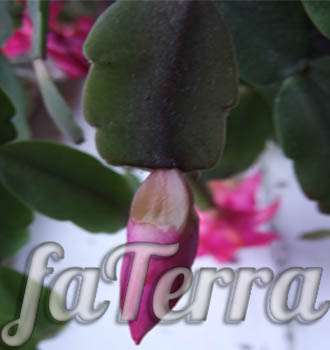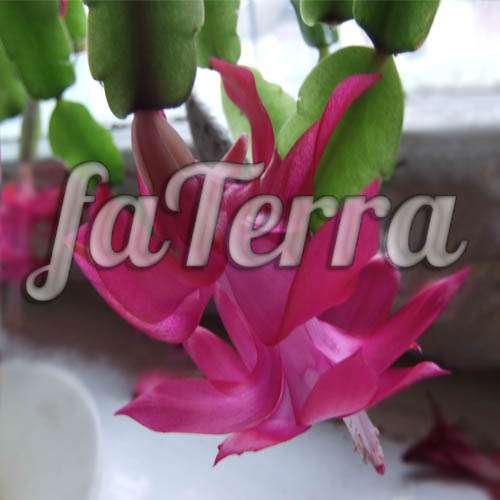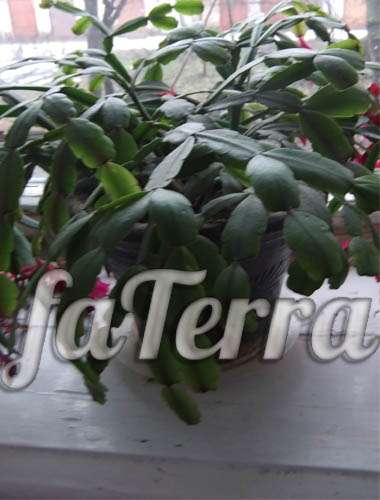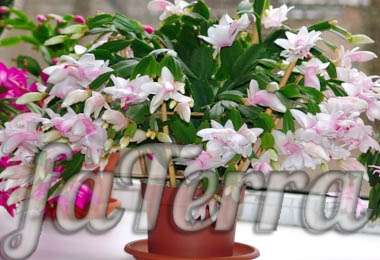Latin name: schlumbergera
Origin: tropical forests in southeastern Brazil
Schlumbergera, zygocactus, Christmas tree, Decembrist
This is a house plant that came to us from the rainforests in the southeast of Brazil. It usually begins flowering at the end of December and pleases us all winter. From its hanging shoots, namely from their endings, Christmas flowers appear, the length of the flower reaches 3-8 cm. The flowers come in a wide variety of colors: white, lavender, purple, red, red-orange, peach, yellow and others. Like all houseplants, zygocactus loves good care, if you take good care of it, then it can please you with flowering up to 3 times a year.
The most common types of Christmas
Schlumbergera Gaertner (Schlumbergera gaertneri)
Schlumberger Gertner The flowers of this plant are orange-red, and the bell has pointed petals, the length of the flowers reaches 7 cm.
Schlumbergera buckley (Schlumbergera buckleyi)
Schlumbergera buckley The flowers are symmetrical lilac-pink, slightly pointed and oblong.
Schlumbergera truncated (Schlumbergera truncatus)
Schlumbergera truncated The flowers are asymmetrical in a variety of shades, the stems are straight. These plants are less resistant to diseases, so the life span is short.
Schlumberger home care
So that your plant does not have more leaves on one side, and less on the other - it is periodically rotated in different directions towards the light, but during the period of flowering and the appearance of buds it should not be disturbed! The more often you prune the Christmas tree (you need to prune non-branching shoots), the more abundant its flowering will be.
Location selection
Rozhdestvennik is easily affected by direct sunlight, because of which burns occur on its leaves.
This plant grows well in a bright place, a north window is ideal.
How to water the Decembrist?
Do not flood the Christmas tree, as this can lead to rotting of the roots (the leaves will begin to wither), do not allow it to dry out, do not pour it with tap water, because it contains chlorine and lime.
It is necessary to water with settled water at room temperature. Likes regular spraying and warm showers. Water abundantly when buds appear and until the end of flowering. Then water when the soil is dry.
Priming
Schlumbergera, like other cacti, requires special soil to ensure health and good growth.
The main criteria for choosing soil for Schlumbergera are water permeability, breathability and nutritional value.
A good soil for Schlumbergera should be light, dense, have good drainage capacity to avoid stagnant water in the roots of the plant. The composition of the soil should include sand, perlite and peat to ensure good breathability and water permeability.
Also for Schlumbergera, it is recommended to use soil that is rich in organic matter and minerals. Coconut fiber or humus can be used as organic additives.
If you can't purchase a special soil for Schlumbergera, you can make your own by mixing 2 parts sand, 1 part perlite, and 1 part peat moss or coconut fibre.
It is important to remember that Schlumbergera prefers slightly acidic soil.
Therefore, if you decide to prepare the soil yourself, make sure that it does not contain excess acidity.
How to transplant a Decembrist
Usually transplanted in late February after flowering. The pot is not deep, but spacious. A good potting mix for cacti is available at any flower shop. You can mix sod, leaf, peat land and sand (evenly pided). Good drainage is required. A young zygocactus is transplanted every 2 years, and an adult - once every 3-5 years.
Top dressing
Feed after the end of flowering (2 - 3 weeks after transplantation) with the usual special fertilizer for cacti.
Reproduction
Schlumbergera is a plant that is usually propagated by cuttings. Here is how you can propagate Schlumbergera:
- Choose a healthy and strong shoot from the mother plant. Choose a shoot that has few leaves and shows no signs of disease or damage.
- Cut off the shoot from the mother plant using a sharp and clean implement. It is best to use secateurs or a knife for this.
- Leave the cut shoot in the air for several hours to dry the surface of the wound.
- After the wound dries, put the shoot in a place where it will receive enough light and heat. The plant must be protected from direct sunlight.
- After a few weeks, roots will appear on the shoot. When the roots reach a length of about 2.5 cm, you can transplant the shoot into a separate pot with soil for cacti or special soil for Schlumbergera.
- Water the new plant after transplanting very carefully so as not to damage the roots. After that, continue to care for the plant as you would the mother plant.
Christmas trees are propagated regardless of the time of year.
You can repeat this propagation process to create many new Schlumbergera plants.
Pests and diseases
Like any other plant, zygocactus can be susceptible to various diseases and pests.
Among the most common diseases that can affect Schlumbergera are root rot, stem rot, bacterial spot and powdery mildew.
- Root and stem rot usually results from overwatering or poor drainage, leading to the development of fungal infections.
- Bacterial spot appears as brown or black spots on leaves and stems.
- Powdery mildew causes a white coating on the leaves.
Among the pests that can attack the Schlumberger are spider mites, scale insects and thrips.
- The spider mite is a microscopic pest that covers the leaves of the plant with a thin cobweb and feeds on their juices, which leads to the drying of the leaves.
- The scale insect is a small pest that covers the leaves and stems with a dense layer of protective resin and feeds on plant juices, which can lead to growth retardation.
- Thrips are small insects that feed on plant sap and can cause yellow spots on the leaves.
To combat diseases and pests of Schlumbergera, it is recommended to monitor the condition of the plant, remove the affected parts of the plant, provide good ventilation and not oversaturate the plant with water. You can also use special preparations to protect plants from diseases and pests.
Problems that may arise
- If your indoor plant does not bloom, or there are few flowers, then you keep it incorrectly, keep it in poor light, do not water it enough, there are no nutrients in the soil.
- Dried leaves turn pale and fall off, brown spots are visible on their surface - damage by scale insects.
- The color of the segments turns pale, the Christmas tree becomes sluggish - when damaged by pests, when exposed to direct sunlight, with irregular watering.
- The plant sheds buds - when the place of the zygocactus changes, it is damaged by pests, the roots rot, insufficient watering or low air temperature.



















Write comments
Comments
Алиас